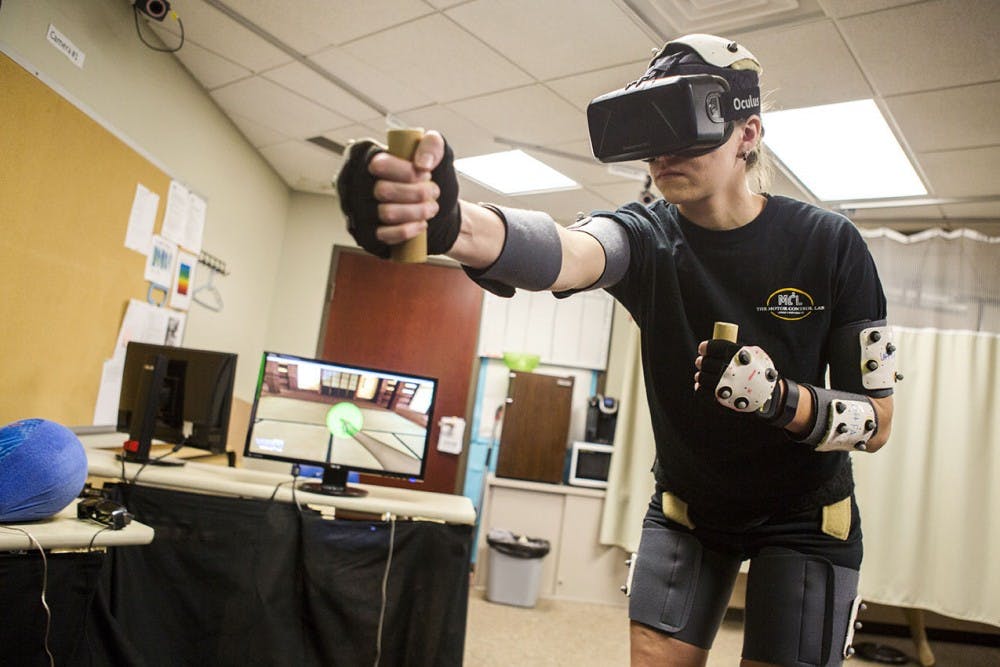Correction appended
With new virtual reality simulations, medical students can practice procedures and gain confidence in their craft faster.
Since receiving an $878,000 grant from Ohio University’s Innovation Strategy program, the Immersive Media Initiative team was able to begin work on a handful of virtual reality projects — they have tackled filmmaking and enhanced journalism, and they have also been busy with multiple VR projects in the medical field.
Last summer, the Immersive Media Initiative shot 360-degree footage of emergency room patients. This was their first project in virtual reality healthcare. Eric Williams, associate professor of media arts and studies and co-creator of Immersive Media Initiative, consulted with Dr. Thanh Nguyen since he is in charge of training six medical students every semester.
Williams said, “Here’s the technology we have, how can we help you train your interns better.”
With the E.R. simulation, medical students have a chance to observe more of the process. Normally, interns would not be able to stand in such a busy area without being in someone’s way, Williams said. They can focus in on one person’s actions and ignore the chaos, and eventually, they will become more relaxed dealing with this type of environment.
James Edelstein, a senior studying digital games and animation, was one of the assistants for capturing the E.R. footage. He helped place cameras, and switched out SD cards and batteries whenever a new patient would come in.
The shoot was more difficult than other VR simulation shoots because they used real patients rather than paid actors, he said.
“We didn’t know when patients were gonna come until 10 or 15 minutes before,” Edelstein said.
Williams said he is affected more by knowing he is watching real patients and the real pain they are experiencing.
Another Immersive Media Initiative venture into VR healthcare involves students interacting more with the technology. The group is collaborating with Todd Fredricks, an assistant professor of family medicine, on a cricothyrotomy simulation. Fredricks said he wishes to “transfer military life saving techniques into the civilian world.”
Their simulation would allow medical students to see what it is like to operate in a handful of extreme scenarios, such as in a helicopter on in a war zone, Williams said in an email.
This procedure helps the operator gain control of the patient’s airway. It is done by an emergency doctor and does not require an operating room, Fredricks said.
Williams said virtual reality lets you “go and and watch the same trauma bay procedure and figure out how everything works.”
Medical students can benefit from using virtual reality as part of their training because traditional methods do not allow for as much access to bodies. There is only a limited supply of cadavers to work on, and the E.R. can receive an unsteady stream of new patients.
“(Virtual reality) not only makes it to feel like a person but makes it look like a person,” Fredricks said.
When medical students are able to practice something until they are comfortable doing it, they are more confident when it comes to them operating on a real patient.
“You are developing muscle memory when you train this way,” Fredricks said.
The cricothyrotomy simulation is still in the experimenting phase, but will be tested on medical students this coming fall, Fredricks said.
For these virtual reality projects, the Immersive Media Initiative is not only partnering with healthcare experts but also the School of Media Arts and Studies. Starting this semester, there will be a virtual reality course for Ohio University students. For the next three years, there will be a few virtual reality courses each semester.
Correction: A previous version of this article incorrectly spelled Dr. Thanh Nguyen's name. The article has been updated to show the most accurate information.






